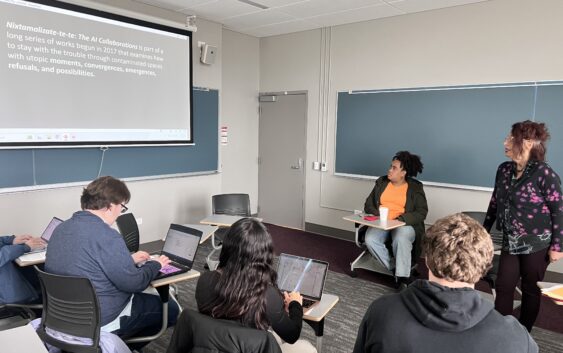Pilar: from technology to Techno-Tamaladas

Eddie Coardos ’26
coardoseem@lakeforest.edu
JOUR 320 Writer
In a recent visit to journalism classes at Lake Forest College, Colombian performance artist and scholar Praba Pilar presented her most innovative approach to art and AI. Since 2017, her project Nixtamalizate-te-te has combined modern technology such as artificial intelligence with indigenous technologies to create sculptures, photography, and community projects.
Her objective is to show the public how “contaminated” our world has become due to reliance on technology and highlight the sense of wonder and beauty of day-to-day life, she said.
“A state of wonder provides the willingness to be surprised and curious enough to engage in present-day artistic, collective, and public projects,” said Pilar.
Praba’s visit to Lake Forest College was made possible by the HUMAN Residency Fellowship with Ragdale, a collaboration that invites artists from diverse disciplines to explore the intersection of artificial intelligence and the humanities. Pilar’s area of expertise is combining artificial intelligence with performances, experimental talks, and other works to challenge “techno-colonialism,”—or more simply put, technology’s increasing dominance over our lives.
Praba Pilar has dedicated the last eight years of her career to Nixtamalizate-te-te to draw our attention to how much of daily life has been taken over by technology. No matter the time or place, chances are you’re never too far from a screen, media, or other kinds of tech, as her work shows.
Her combination of indigenous technologies like nixtamalization (an ancient process used in Central America to prepare corn) allows Praba to illustrate the beauty of natural technologies and highlight how much of daily life has been taken over by modern technology.
Praba believes that hoping for change is no longer enough. Nixtamalizate-te-te offers her audience ways of thinking about and challenging capitalist and technological development in the present. She combines artificial intelligence with digital photography and music to show that we can do more than just hope; we can actively create change.
“I didn’t want to keep operating on hope,” says Praba. “Hope makes people lose accountability of the present.”
For Praba, our ability to experience utopia in daily life—that is, small moments of happiness, kindness, or beauty that are usually overlooked—is at stake. To her, the generosity and acts of kindness that we witness so often are the same as utopia. Praba’s work illustrates the beauty of these small moments and demonstrates the importance of living in the moment and appreciating the beauty that exists in the mundane.
“Many people don’t realize the little mundane generosities that they are exposed to every day,” she said.
In one of her projects, Praba created a song with lyrics written by ChatGPT (an artificial intelligence bot). The song’s background video featured a photograph depicting technology taking over human life. Interestingly, the ChatGPT-created lyrics called for revolution. This suggests even artificial intelligence recognizes the beauty of life lost in technology, and how humans are less able to appreciate the minute positive things that happen to them every day. Pilar’s use of artificial intelligence to create a song that denounces technology is paradoxical – but this is what makes her work so striking.
Pilar has also led many community events like food drives and workshops where people learn about indigenous technology. One of her community projects, called ‘Techno-Tamaladas,’ teaches its attendees the technology of nixtamalization, and how it differs from the technology we use now.
“Projects like this are all around us already, they’re in the world that we are in at present,” she said.
